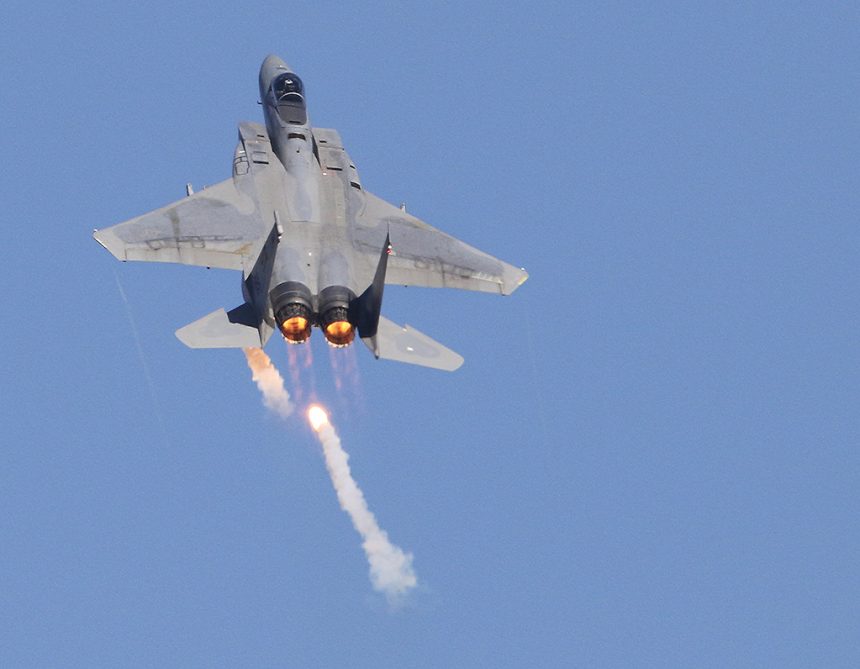Condition of Pilot Unknown Following Rescue. It’s the sixth USAF crash since the beginning of 2018.
A USAF F-15C Eagle belonging to the 18th Wing at Kadena AB, Okinawa has crashed into the ocean off Okinawa, Japan, at approximately 0640 Hrs. Monday morning, June 11, 2018 Okinawa local time. According to the Japan Times the aircraft went down about 80 km south of Naha, capital of the Okinawa prefecture.
Reports indicate the pilot ejected from the aircraft prior to impact. The pilot was rescued at sea following his ejection by a Japanese Self-Defense Force helicopter. The condition of the single aircrew onboard the F-15C Eagle has not been released.
The 18th Wing at Kadena AFB is home to two F-15C/D Eagle fighter squadrons, the 44th Fighter Squadron, the “Vampire Bats” and the 67th Fighter Squadron, the “Fighting Cocks”. It is unclear which squadron the F-15C involved in Monday’s crash came from.
In an earlier incident five years ago on May 28, 2013, another USAF F-15C Eagle crashed off Kadena. In that crash, an investigation revealed that;
“The cause of the accident was the aircraft failing to respond to the pilot’s flight control inputs due to a failure in the aircraft’s hydro-mechanical flight control system. Additionally, the Pitch Roll Channel Assembly provided inputs to the flight control surfaces not commanded by the aircraft pilot. The investigation also found by a preponderance of evidence that the pilot had limited time for malfunction analysis and a lack of simulator emergency procedure training for the malfunction in the hydro-mechanical flight control system also substantially contributed to the accident.”
In the 2013 accident the pilot also ejected from the aircraft and survived. Obviously there is currently no evidence that the two crashes are related. The cause of the accident Monday morning in Okinawa is unknown pending an official USAF investigation.
In November of 2007, all USAF F-15 aircraft were grounded after a Missouri Air National Guard F-15C came apart in flight and crashed on November 2, 2007. The 2007 accident was found to be a result of a defect in the aircraft’s upper right longeron. The upper right longeron is a structural component in the fuselage that provides strength to the area where the cockpit and the fuselage meet. Following the November, 2007 crash, a January 10, 2008 report indicated that nine additional F-15s were found to have similar structural problems. The failure of the upper right fuselage longeron originated from a defect in manufacturing according to the official report.
At the time of the 2007 incident, a story filed by USAF Staff Sgt. J.G. Buzanowski quoted USAF (then) Col. William Wignall, head of the accident investigation as saying that, “We’ve had great involvement from Boeing during the investigation. In fact, they’re the ones who determined the longeron was the problem. This was then confirmed by the Air Force Research Laboratory.”
But USAF General John D.W. Corley, then-commander of Air Combat Command, went on to report in 2007 that, “The difficulty is that issues have been found with F-15s built between 1978 and 1985, across A through D models at several bases, so no one source of the problem can be isolated. This isn’t just about one pilot in one aircraft with one bad part. I have a fleet that is 100 percent fatigued, and 40 percent of that has bad parts. The long-term future of the F-15 is in question.”
In April of 2018, Boeing was awarded a modification to an existing contract for F-15 modernization that includes an upgrade to the Raytheon AN/APG-82(V) radar. According to a Defense Industry Daily report the contract called for, “Work on 29 Group A and Group B kits, spares, fuel tanks and other equipment and services.” The upgrade contract was valued at $187M USD. It is unclear if any part of the new contract applies to structural elements of the F-15 Eagle.
The McDonnell-Douglas/Boeing F-15C Eagle is a twin-engine, single seat air superiority fighter first flown in 1972. The aircraft is in service with several air forces including the U.S., Japan, Saudi Arabia and Israel. The F-15C Eagle and the two-seat variants including the F-15E Strike Eagle, have been extremely successful combat aircraft with an impressive record in operational use.
The F-15C crash on Jun. 11 is the sixth U.S. Air Force (eleventh U.S. military aviation) since the beginning of the year. The most recent ones involved a WC-130H from the 156th Airlift Wing from Puerto Rico ANG that crashed near Chatham City, Georgia on May 2, 2018, causing 9 deaths and a T-38 that crashed 9 miles north of the city of Columbus on May 23, 2018. In the latter event, the pilots managed to eject.
Top image: File Photo of an F-15C Eagle as it releases flares. (Credit: Tom Demerly/TheAviationist)








